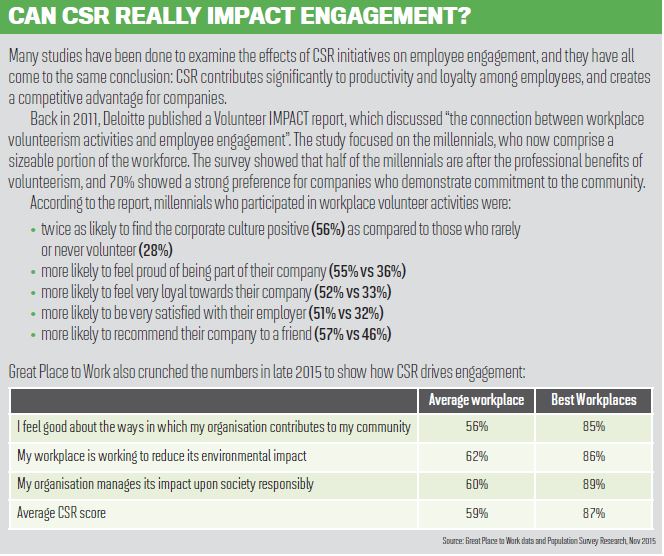Sam Neo outlines why CSR is more than just a ‘nice to have’ and how HR can unlock the true value of CSR initiatives

Sam Neo outlines why CSR is more than just a ‘nice to have’ and how HR can unlock the true value of CSR initiatives
CORPORATE SOCIAL RESPONSIBILITY
(CSR) activities are often seen as a tool to enhance corporate image and make individuals feel good. But is that all CSR can deliver? Is it really a standalone portfolio? Can it actually complement your organisation’s people agenda?
Back in my earlier days when I was heavily involved in driving a charitable foundation and volunteer group, I came to realise that CSR activities actually have more potential than most people perceive. In fact, they should be a key pillar for HR and the organisation. Why so? Let’s explore further.
For the former, instead of randomly assigning, a more purpose-driven approach could be taken. Young leaders or highpotentials in companies can be tasked to spearhead such programs to test their ability to lead in a controlled environment. Besides that, they will have the opportunity to work with people outside of their comfort zone and develop skills that may not be readily honed in their current scope of work. Areas that talent can be exposed to may include project management, strategic planning and even external stakeholder management. This can be supplemented with the donation dollar to create a win-win situation for both the beneficiary and the organisation.

 Sam Neo is the assistant manager, HR business partnership and scholarship, at Changi Airport Group.
Sam Neo is the assistant manager, HR business partnership and scholarship, at Changi Airport Group.
CORPORATE SOCIAL RESPONSIBILITY
(CSR) activities are often seen as a tool to enhance corporate image and make individuals feel good. But is that all CSR can deliver? Is it really a standalone portfolio? Can it actually complement your organisation’s people agenda?
Back in my earlier days when I was heavily involved in driving a charitable foundation and volunteer group, I came to realise that CSR activities actually have more potential than most people perceive. In fact, they should be a key pillar for HR and the organisation. Why so? Let’s explore further.
- Talent development platform
For the former, instead of randomly assigning, a more purpose-driven approach could be taken. Young leaders or highpotentials in companies can be tasked to spearhead such programs to test their ability to lead in a controlled environment. Besides that, they will have the opportunity to work with people outside of their comfort zone and develop skills that may not be readily honed in their current scope of work. Areas that talent can be exposed to may include project management, strategic planning and even external stakeholder management. This can be supplemented with the donation dollar to create a win-win situation for both the beneficiary and the organisation.
- Create shared experiences
- Opportunity for cross-entity interaction

- Boost mental wellness
- Build a company with strong ‘heartware’
- Closing thoughts
 Sam Neo is the assistant manager, HR business partnership and scholarship, at Changi Airport Group.
Sam Neo is the assistant manager, HR business partnership and scholarship, at Changi Airport Group.




